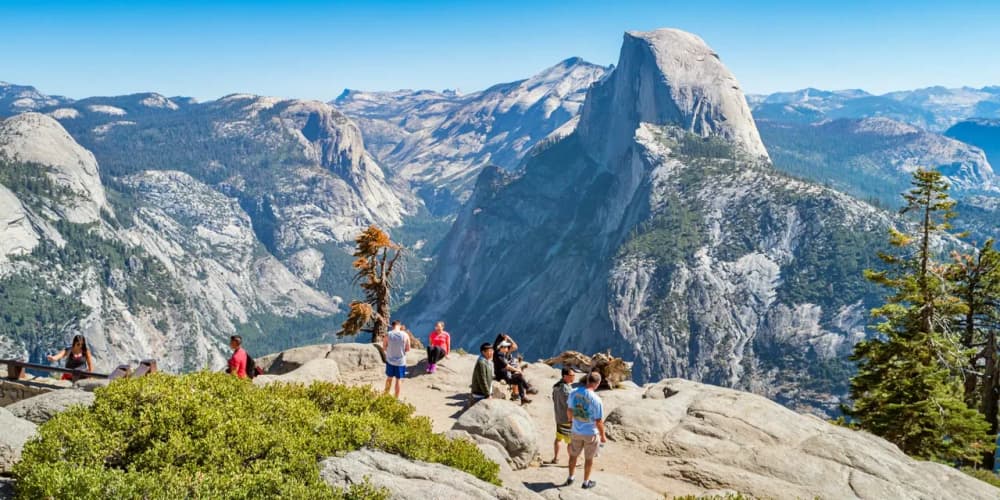Yosemite National Park in California is famed for tall granite cliffs, giant sequoia groves, and iconic waterfalls. It offers multiday hikes, climbing, and valley panoramas.
Geography
| Continent | North America |
|---|---|
| Region | Sierra Nevada |
| Subregion | California Central Sierra |
| Country | United States |
| State | California |
| County | Mariposa County and Tuolumne County |
| District | Yosemite National Park |
| Timezone | AmericaLos Angeles |
| Latitude | 37.8651 |
| Longitude | -119.5383 |
| Maps |
Yosemite National Park spans over 3,000 square kilometers of raw Sierra Nevada wilderness. Crowned by Tallest granite cliffs like El Capitan and Half Dome, the park's dramatic landscapes include sharp peaks, U-shaped glacial valleys, and expansive meadows. In the Yosemite Valley, visitors find famous landmarks, thundering waterfalls like Yosemite Falls, and access to hiking and climbing routes. The park is also a guardian of centuries-old giant sequoia groves, notably Mariposa Grove. Outside the valley, high country trails, alpine lakes, and remote backcountry become accessible with seasonal planning — usually summer to early fall, with winter's snow reshaping routes and access for certain areas.
Useful Products
We think these products might be useful on your journey!
Category: Gear
Price: $60 – $120
Carry essentials on day hikes through Yosemite National Park. This 40L pack features a ventilated back panel and ergonomic straps for all-day comfort on granite trails. Ventilated back panel and ergonomic straps keep you moving.
Category: Gear
Price: $15 – $30
Stay hydrated on Mist Trail expeditions and long ascents in Yosemite National Park. The 2L reservoir fits most packs and includes a reliable bite valve. Leak-proof design helps prevent spills.
Category: Gear
Price: $25 – $40
Filter stream water on the go and cut down on plastic bottles during backcountry days at Yosemite National Park. This bottle provides simple filtration for safe drinking. Water filtration and eco-friendly use.
Category: Gear
Price: $120 – $260
Perfect for campground nights near Yosemite National Park or less crowded backcountry trips. This two person tent balances weight and stability. Backcountry ready and easy setup.
Category: Tech
Price: $25 – $50
Power your phone and camera during long valley days in Yosemite National Park. The 20,000mAh bank keeps devices charged between sunrise shots. Fast charging and high capacity.
Category: Tech
Price: $15 – $40
Expand your frame to capture vast granite walls and cascading waterfalls in Yosemite National Park. This lens adds dramatic perspective. Wide-angle and easy attachment.
Category: Clothing
Price: $70 – $150
Windproof and waterproof layer for sudden spring storms near Yosemite National Park. This jacket keeps you warm without bulk. Windproof and waterproof protection.
Category: Clothing
Price: $15 – $25
Moisture-wicking socks help blister prevention on long switchbacks around Yosemite National Park. Keep feet dry and comfy. Moisture-wicking and blister-resistant.
Category: Footwear
Price: $50 – $140
Grip on granite and wet rocks around Yosemite National Park is essential on many trails. These shoes provide traction for mixed terrain. Grippy soles and supportive fit.
Category: Gear
Price: $15 – $35
Pre-dawn starts and campsite evenings in Yosemite National Park benefit from hands-free lighting. Red light preserves night vision. Red light and hands-free.
Category: Gear
Price: $25 – $60
Cook hot meals at camp after long days exploring Yosemite National Park viewpoints. This stove is compact and efficient. Ultralight and efficient.
Category: Gear
Price: $20 – $50
Stability on steep ascents and uneven granite trails near Yosemite National Park. These poles reduce knee stress. Stability and weight support.
Category: Health
Price: $7 – $20
Basics for hike safety and minor injuries in the park. This compact kit covers essentials. First aid and travel-ready.
Category: Gear
Price: $6 – $15
Offline navigation for park routes when cell service is spotty in Yosemite National Park. Keeps maps protected from rain. Offline navigation and waterproof.
Category: Gear
Price: $10 – $25
Stabilize shots of waterfalls like Yosemite National Park and capture long exposures on park mornings. This mini tripod is travel friendly. Long exposure and compact.
Category: Beauty
Price: $6 – $15
High elevation sun protection for reflective granite in Yosemite National Park. This sunscreen protects skin during hikes and on exposed rocks. SPF 50 and water resistant.
Category: Beauty
Price: $2 – $6
Windy, exposed ridges can dry lips quickly in the mountains near Yosemite National Park. This balm with SPF keeps lips soft. SPF lip protection.
Category: Comfort
Price: $8 – $20
Rest between trails or at viewpoints along the valley floor. Lightweight cushion adds comfort. Portable and ultra-soft.
Category: Electronics
Price: $70 – $130
Capture fast changing scenery with a compact camera or action cam on hikes and road trips through Yosemite National Park. Great for 4K video and wide dynamic range shots.
All content was written by our AI and may contain a few mistakes. We may earn commissions on some links. Last updated: Sun Dec 14, 2025, 2:46 AM





